An Assessment of Productivity Patterns of Grass-Dominated Rangelands in the Hindu Kush Karakoram Region, Pakistan
Abstract
:1. Introduction
2. Materials and Methods
2.1. Study Area
2.2. Datasets and Data Pre-Processing
2.2.1. Reconstruction of NDVI Time-Series
- NDVIt = NDVI of the pixel at day of the year (DOY).
- NDVImin = Minimum NDVI of the NDVI trajectory during the year (lower asymptote).
- NDVId = Difference between minimum and maximum (lower and upper asymptote) of the NDVI trajectory during the year.
- = Position of the left inflection point (change of concavity), point (DOY) where the slope of the function has a maximum change (maximum rate of increase in NDVI) in spring at the start of the season.
- = Position of the right inflection point (change of concavity), point (DOY) where the slope of the function has a maximum change (maximum rate of decrease in NDVI) in autumn.
- = Maximum slope of the curve at the left inflection point, maximum rate of increase in NDVI
- = Maximum slope of the curve at the right inflection point, maximum rate of decrease in NDVI.
2.2.2. Grassland Mask
- Pixels with weak NDVI values (<0.05) were excluded.
- Pixel that were already classified as non-rangelands, such as forests, snow/glaciers, cultivated areas, water, bare lands and urban areas, were removed.
- At higher elevations, because of the prolonged length of the season along with the high productivity and lower maximum seasonal NDVI, the decision was made to mask out evergreen scrub forests (the decision rule was made based on several observations of Google Earth images.
- At mid altitudes in forest zones, forested areas were identified and eliminated based on the extended seasonal length and high NDVI values throughout the year.
- Noisy pixels were further filtered and excluded using a histogram analysis of vegetation phenology based on factors such as a very late start of the growing season (SGST > 230).
2.3. Evaluation of Productivity Metrics
2.4. Rangeland Growth Trends
2.5. Ecological Zones and Analysis
3. Results
3.1. Rangeland Productivity Patterns
3.2. Greening and Browning Trends
4. Discussion
5. Conclusions
Acknowledgments
Author Contributions
Conflicts of Interest
References
- Breman, H.; de Wit, C.T. Rangeland productivity and exploitation in the sahel. Science 1983, 221, 1341–1347. [Google Scholar] [CrossRef] [PubMed]
- Vetter, S. Rangelands at equilibrium and non-equilibrium: Recent developments in the debate. J. Arid Environ. 2005, 62, 321–341. [Google Scholar] [CrossRef]
- Ellis, J.E.; Swift, D.M. Stability of African Pastoral Ecosystems: Alternate Paradigms and Implications for Development. J. Range Manag. 1988, 41, 450–459. [Google Scholar] [CrossRef]
- Illius, A.W.; O’Connor, T.G. On the relevance of nonequilibrium concepts to arid and semiarid grazing systems. Ecol. Appl. 1999, 9, 798–813. [Google Scholar] [CrossRef]
- Joshi, L.; Shrestha, R.M.; Jasra, A.W.; Joshi, S.; Gilani, H.; Ismail, M. Rangeland ecosystem services in the Hindu Kush Himalayan Region. In High-Altitude Rangelands and Their Interfaces in the Hindu Kush Himalayas; Ning, W., Rawat, G.S., Joshi, S., Ismail, M., Sharma, E., Eds.; The International Centre for Integrated Mountain Development (ICIMOD): Kathmandu, Nepal, 2013; pp. 157–174. [Google Scholar]
- Mansouri Daneshvar, M.R.; Bagherzadeh, A.; Khosravi, M. Assessment of drought hazard impact on wheat cultivation using standardized precipitation index in Iran. Arab. J. Geosci. 2012, 6, 4463–4473. [Google Scholar] [CrossRef]
- Beniston, M. Climatic change in mountain regions: A review of possible impacts. Clim. Chang. 2003, 59, 5–31. [Google Scholar] [CrossRef]
- Nüsser, M.; Clemens, J. Impacts on Mixed Mountain Agriculture in the Rupal Valley, Nanga Parbat, Northern Pakistan. Mt. Res. Dev. 1996, 16, 117–133. [Google Scholar] [CrossRef]
- Kreutzmann, H. Pastoral Practices and their Transformation in the North-Western Karakoram. Nomadic Peoples 2004, 8, 54–88. [Google Scholar] [CrossRef]
- Rahman, A.; Duncan, A.J.; Miller, D.W.; Clemens, J.; Frutos, P.; Gordon, I.J.; Rehman, A.U.R.; Baig, A.; Ali, F.; Wright, I.A. Livestock feed resources, production and management in the agro-pastoral system of the Hindu Kush-Karakoram-Himalayan region of Pakistan: The effect of accessibility. Agric. Syst. 2008, 96, 26–36. [Google Scholar] [CrossRef]
- Eklundh, L.; Olsson, L. Vegetation index trends for the African Sahel 1982–1999. Geophys. Res. Lett. 2003, 30, 1430. [Google Scholar] [CrossRef]
- Tadesse, T.; Brown, J.F.; Hayes, M.J. A new approach for predicting drought-related vegetation stress: Integrating satellite, climate, and biophysical data over the US central plains. ISPRS J. Photogramm. Remote Sens. 2005, 59, 244–253. [Google Scholar] [CrossRef]
- Liu, L.; Liu, L.; Liang, L.; Donnelly, A.; Park, I.; Schwartz, M.D. Effects of elevation on spring phenological sensitivity to temperature in Tibetan Plateau grasslands. Chinese Sci. Bull. 2014, 59, 4856–4863. [Google Scholar] [CrossRef]
- Omer, R.M.; Hester, A.J.; Gordon, I.J.; Swaine, M.D.; Raffique, S.M. Seasonal changes in pasture biomass, production and offtake under the transhumance system in northern Pakistan. J. Arid Environ. 2006, 67, 641–660. [Google Scholar] [CrossRef]
- Tucker, C.J.; Sellers, P.J. Satellite remote sensing of primary production. Int. J. Remote Sens. 1986, 7, 1395–1416. [Google Scholar] [CrossRef]
- Rigge, M.; Smart, A.; Wylie, B.; Gilmanov, T.; Johnson, P. Linking Phenology and Biomass Productivity in South Dakota Mixed-Grass Prairie. Rangel. Ecol. Manag. 2013, 66, 579–587. [Google Scholar] [CrossRef]
- Pettorelli, N.; Vik, J.O.; Mysterud, A.; Gaillard, J.-M.; Tucker, C.J.; Stenseth, N.C. Using the satellite-derived NDVI to assess ecological responses to environmental change. Trends Ecol. Evol. 2005, 20, 503–510. [Google Scholar] [CrossRef] [PubMed]
- Huete, A.; Didan, K.; Miura, T.; Rodriguez, E.; Gao, X.; Ferreira, L. Overview of the radiometric and biophysical performance of the MODIS vegetation indices. Remote Sens. Environ. 2002, 83, 195–213. [Google Scholar] [CrossRef]
- Thein, T.R.; Watson, F.G.R.; Cornish, S.S.; Anderson, T.N.; Newman, W.B.; Lockwood, R.E. Vegetation Dynamics of Yellowstone’s Grazing System. Terr. Ecol. 2008, 3, 113–133. [Google Scholar]
- Zhu, Z.; Bi, J.; Pan, Y.; Ganguly, S.; Anav, A.; Xu, L.; Samanta, A.; Piao, S.; Nemani, R.; Myneni, R. Global Data Sets of Vegetation Leaf Area Index (LAI)3g and Fraction of Photosynthetically Active Radiation (FPAR)3g Derived from Global Inventory Modeling and Mapping Studies (GIMMS) Normalized Difference Vegetation Index (NDVI3g) for the Period 1981 to 2011. Remote Sens. 2013, 5, 927–948. [Google Scholar]
- Fensholt, R.; Sandholt, I.; Rasmussen, M.S. Evaluation of MODIS LAI, fAPAR and the relation between fAPAR and NDVI in a semi-arid environment using in situ measurements. Remote Sens. Environ. 2004, 91, 490–507. [Google Scholar] [CrossRef]
- Wang, J.; Rich, P.M.; Price, K.P.; Kettle, W.D. Relations between NDVI and tree productivity in the central Great Plains. Int. J. Remote Sens. 2004, 25, 3127–3138. [Google Scholar] [CrossRef]
- Bradley, B.A.; Jacob, R.W.; Hermance, J.F.; Mustard, J.F. A curve fitting procedure to derive inter-annual phenologies from time series of noisy satellite NDVI data. Remote Sens. Environ. 2007, 106, 137–145. [Google Scholar] [CrossRef]
- Xu, L.; Myneni, R.B.; Chapin, F.S., III; Callaghan, T.V.; Pinzon, J.E.; Tucker, C.J.; Zhu, Z.; Bi, J.; Ciais, P.; Tømmervik, H.; et al. Temperature and vegetation seasonality diminishment over northern lands. Nat. Clim. Chang. 2013, 3, 581–586. [Google Scholar] [CrossRef]
- Nemani, R.R.; Keeling, C.D.; Hashimoto, H.; Jolly, W.M.; Piper, S.C.; Tucker, C.J.; Myneni, R.B.; Running, S.W. Climate-driven increases in global terrestrial net primary production from 1982 to 1999. Science 2003, 300, 1560–1563. [Google Scholar] [CrossRef] [PubMed]
- Potter, C.S.; Klooster, S.; Brooks, V. Interannual Variability in Terrestrial Net Primary Production: Exploration of Trends and Controls on Regional to Global Scales. Ecosystems 1999, 2, 36–48. [Google Scholar] [CrossRef]
- Archer, D.R.; Fowler, H.J. Spatial and temporal variations in precipitation in the Upper Indus Basin, global teleconnections and hydrological implications. Hydrol. Earth Syst. Sci. 2004, 8, 47–61. [Google Scholar] [CrossRef]
- Rhee, J.; Im, J.; Carbone, G.J.; Jensen, J.R. Delineation of climate regions using in-situ and remotely-sensed data for the Carolinas. Remote Sens. Environ. 2008, 112, 3099–3111. [Google Scholar] [CrossRef]
- Vancutsem, C.; Ceccato, P.; Dinku, T.; Connor, S.J. Evaluation of MODIS land surface temperature data to estimate air temperature in different ecosystems over Africa. Remote Sens. Environ. 2010, 114, 449–465. [Google Scholar] [CrossRef]
- Schwarz, N.; Schlink, U.; Franck, U.; Großmann, K. Relationship of land surface and air temperatures and its implications for quantifying urban heat island indicators—An application for the city of Leipzig (Germany). Ecol. Indic. 2012, 18, 693–704. [Google Scholar] [CrossRef]
- Immerzeel, W.W.; Droogers, P.; de Jong, S.M.; Bierkens, M.F.P. Large-scale monitoring of snow cover and runoff simulation in Himalayan river basins using remote sensing. Remote Sens. Environ. 2009, 113, 40–49. [Google Scholar] [CrossRef]
- Fernandes, J.L.; Rocha, J.V.; Augusto, R.; Lamparelli, C. Sugarcane yield estimates using time series analysis of spot vegetation images temporais de imagens spot vegetation. Distribution 2011, 68, 139–146. [Google Scholar]
- Chen, J.; Jönsson, P.; Tamura, M.; Gu, Z.; Matsushita, B.; Eklundh, L. A simple method for reconstructing a high-quality NDVI time-series data set based on the Savitzky–Golay filter. Remote Sens. Environ. 2004, 91, 332–344. [Google Scholar] [CrossRef]
- Fisher, J.; Mustard, J.; Vadeboncoeur, M. Green leaf phenology at Landsat resolution: Scaling from the field to the satellite. Remote Sens. Environ. 2006, 100, 265–279. [Google Scholar] [CrossRef]
- Heumann, B.W.; Seaquist, J.W.; Eklundh, L.; Jönsson, P. AVHRR derived phenological change in the Sahel and Soudan, Africa, 1982–2005. Remote Sens. Environ. 2007, 108, 385–392. [Google Scholar] [CrossRef]
- Butt, B.; Turner, M.D.; Singh, A.; Brottem, L. Use of MODIS NDVI to evaluate changing latitudinal gradients of rangeland phenology in Sudano-Sahelian West Africa. Remote Sens. Environ. 2011, 115, 3367–3376. [Google Scholar] [CrossRef]
- Busetto, L.; Colombo, R.; Migliavacca, M.; Cremonese, E.; Meroni, M.; Galvagno, M.; Rossini, M.; Siniscalco, C.; Morra Di Cella, U.; Pari, E. Remote sensing of larch phenological cycle and analysis of relationships with climate in the Alpine region. Glob. Chang. Biol. 2010, 16, 2504–2517. [Google Scholar] [CrossRef]
- Shehzad, K.; Qamer, F.M.; Murthy, M.S.R.; Abbas, S.; Bhatta, L.D. Deforestation trends and spatial modelling of its drivers in the dry temperate forests of northern Pakistan—A case study of Chitral. J. Mt. Sci. 2014, 11, 1192–1207. [Google Scholar] [CrossRef]
- Chen, J.; Chen, J.; Liao, A.; Cao, X.; Chen, L.; Chen, X.; He, C.; Han, G.; Peng, S.; Lu, M.; et al. Global Land Cover Mapping at 30 m Resolution: A POK-Based Operational Approach. ISPRS J. Photogramm. Remote Sens. 2014, 103, 7–27. [Google Scholar] [CrossRef]
- Vrieling, A.; Beurs, K.M.; Brown, M.E. Variability of African farming systems from phenological analysis of NDVI time series. Clim. Change. 2011, 109, 455–477. [Google Scholar] [CrossRef]
- Shrestha, U.B.; Gautam, S.; Bawa, K.S. Widespread climate change in the Himalayas and associated changes in local ecosystems. PLoS ONE 2012, 7, e36741. [Google Scholar] [CrossRef] [PubMed]
- Meng, M.; Ni, J.; Zong, M. Impacts of changes in climate variability on regional vegetation in China: NDVI-based analysis from 1982 to 2000. Ecol. Res. 2011, 26, 421–428. [Google Scholar] [CrossRef]
- De Jong, R.; de Bruin, S.; de Wit, A.; Schaepman, M.E.; Dent, D.L. Analysis of monotonic greening and browning trends from global NDVI time-series. Remote Sens. Environ. 2011, 115, 692–702. [Google Scholar] [CrossRef]
- Kariyeva, J.; van Leeuwen, W.J.D. Environmental Drivers of NDVI-Based Vegetation Phenology in Central Asia. Remote Sens. 2011, 3, 203–246. [Google Scholar] [CrossRef]
- Reed, B.; Brown, J. Measuring phenological variability from satellite imagery. J. Veg. Sci. 1994, 5, 703–714. [Google Scholar] [CrossRef]
- Seth, C.M. Biomass fluctuation in alpine pastures of Kashmir Himalaya. Ann. Arid Zone 1996, 35, 65–67. [Google Scholar]
- Sardar, M.R. Indigenous Production and Utilization Systems in the High Altitude Alpine Pasture, Saif-Ul-Maluk (NWFP), Pakistan.; FAO and Pakistan Forest Institute: Peshawar, Pakistan, 1997. [Google Scholar]
- Holechek, J.L.; Pieper, R.D.; Herbel, C.H. Range Management, Principles and Practices, 3rd ed.; Prentice-Hall: Upper Saddle River, NJ, USA, 1998. [Google Scholar]
- Misri, B. Improvement of Sub-alpine and Alpine Himalayan Pastures, 2013. Food and Agriculture Organization of the United Nations. Available online: http://www.fao.org/ag/AGP/AGPC/doc/pasture/peshawarproceedings/improvementsubalpine.pdf (accessed on 14 September 2016).
- Qureshi, R.A.; Gilani, S.A.; Ashraf, M. Ethnobotanical studies with special reference to plants phenology at Sudhan Gali and Ganga Chotti Hills (District Bagh, A.K.). Electron. J. Environ. Agric. Food Chem. 2007, 6, 2207–2215. [Google Scholar]
- Saqib, Z.; Sultan, A. Ethnobotany of Palas Valley, Pakistan. Ethnobot. Leafl. 2005, 1, 28. Available online: http://opensiuc.lib.siu.edu/ebl/vol2005/iss1/28/ (accessed on 14 September 2016). [Google Scholar]
- Stoddart, L.A.; Smith, A.D.; Box, T.W. Range Management, 3rd ed.; McGraw-Hill Book Company: New York, NY, USA, 1975. [Google Scholar]
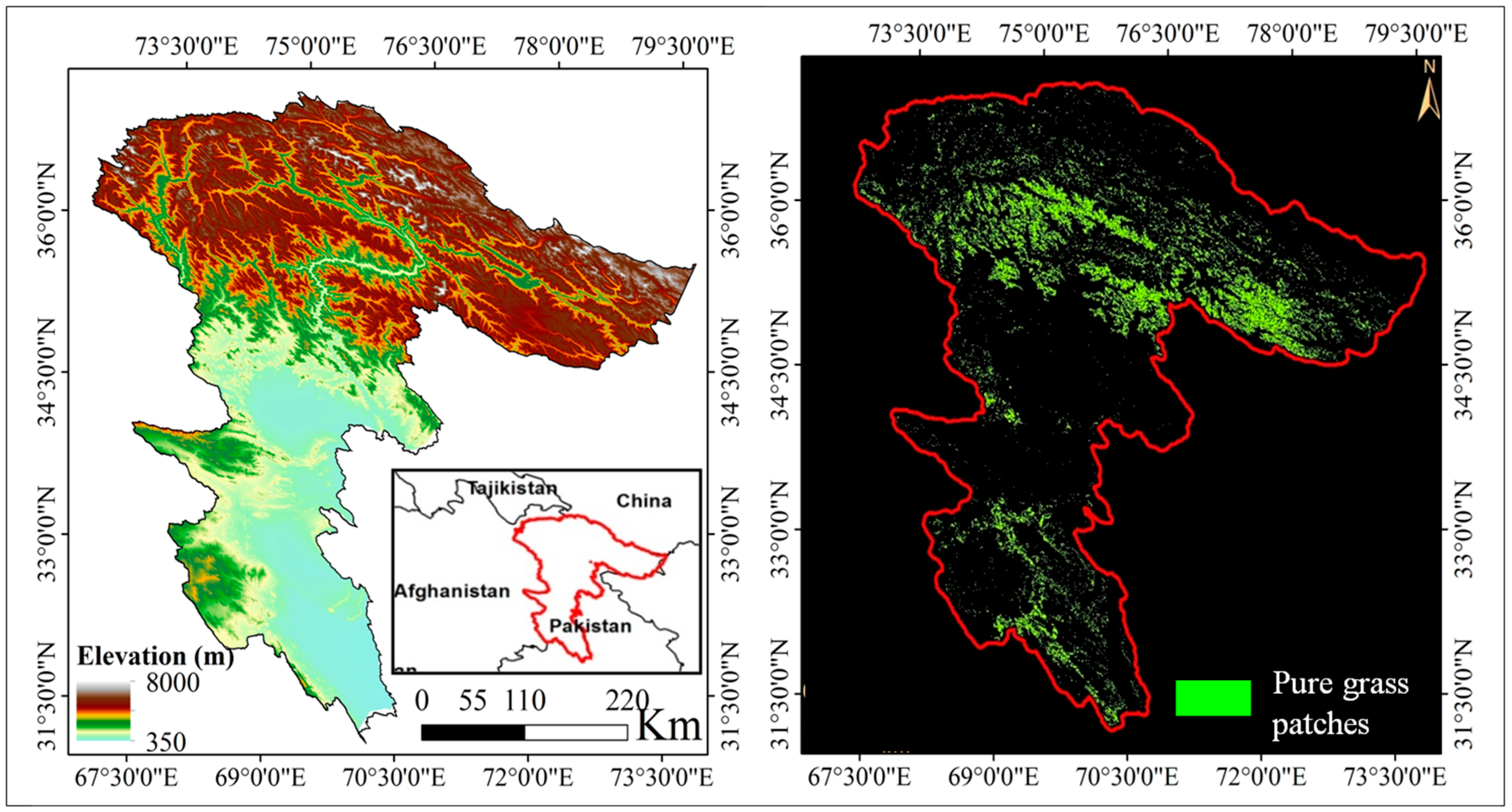

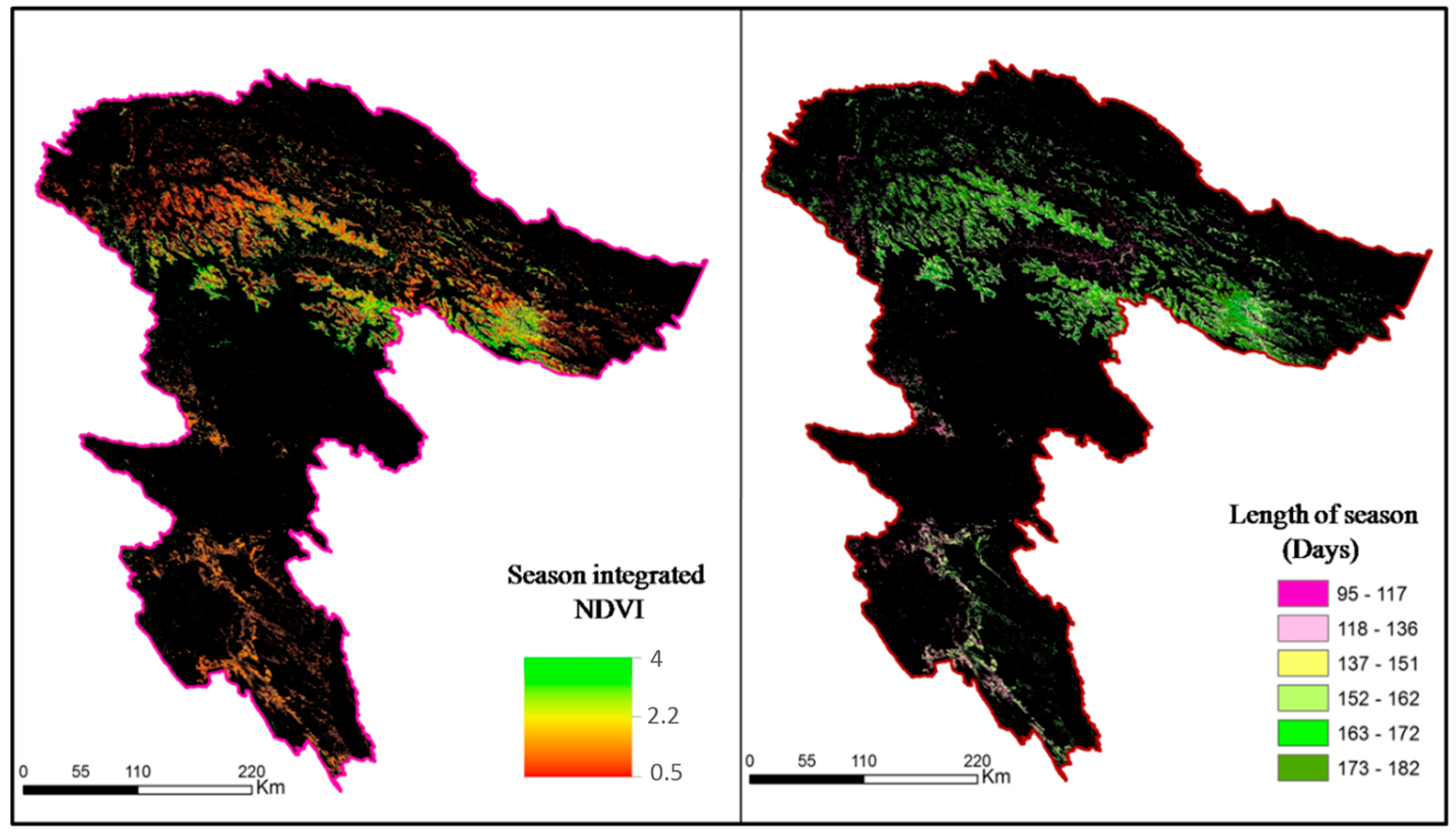
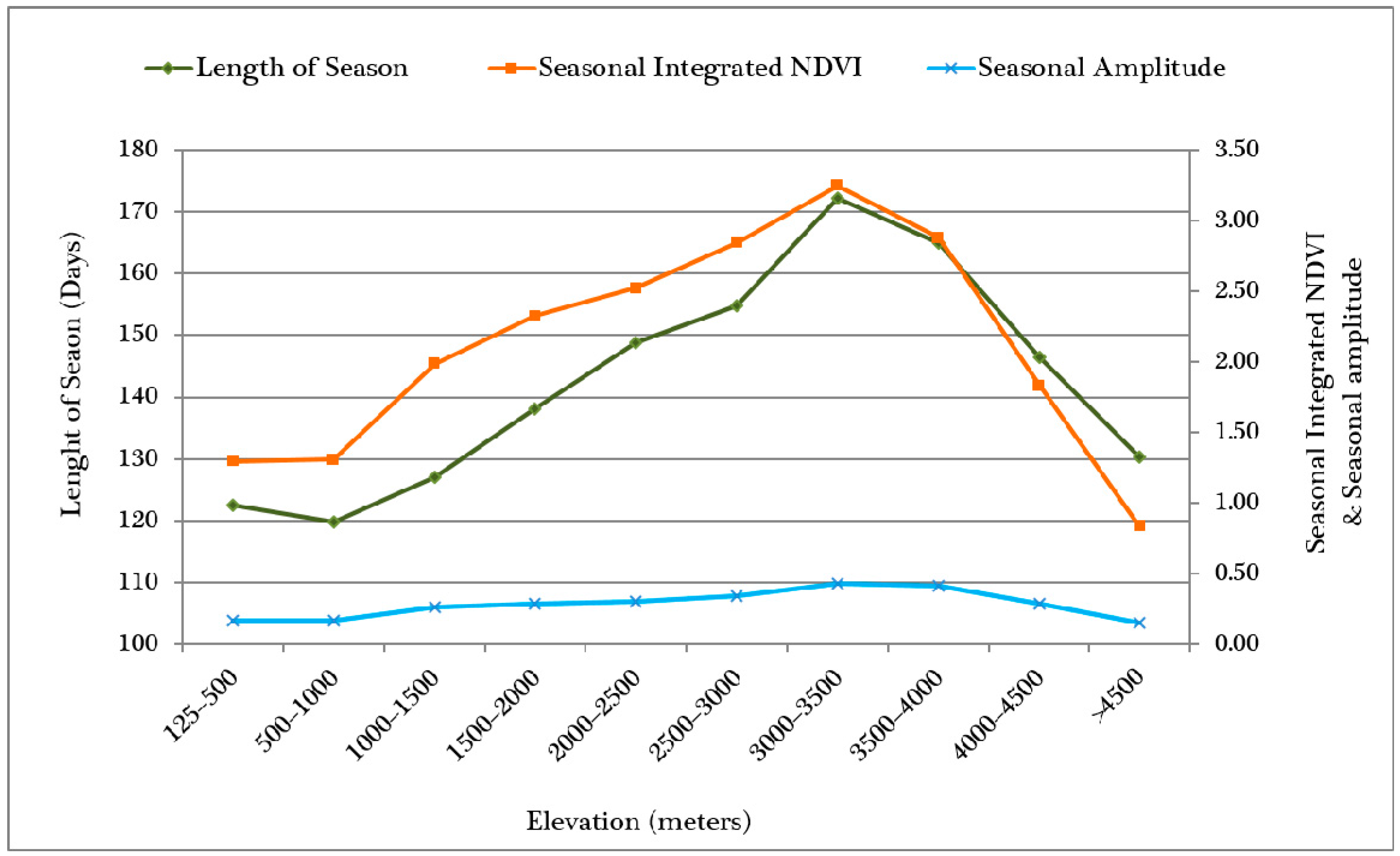
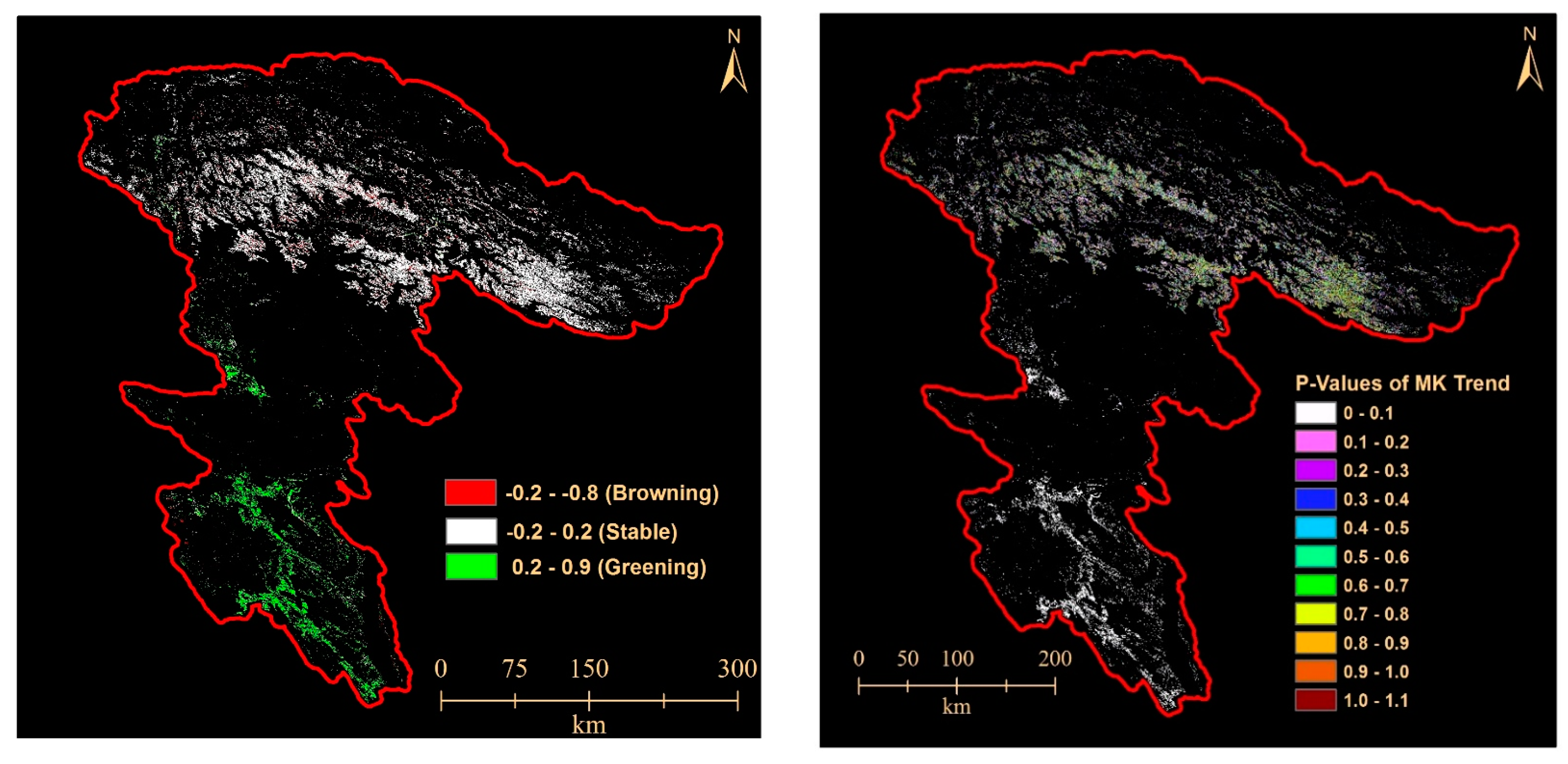
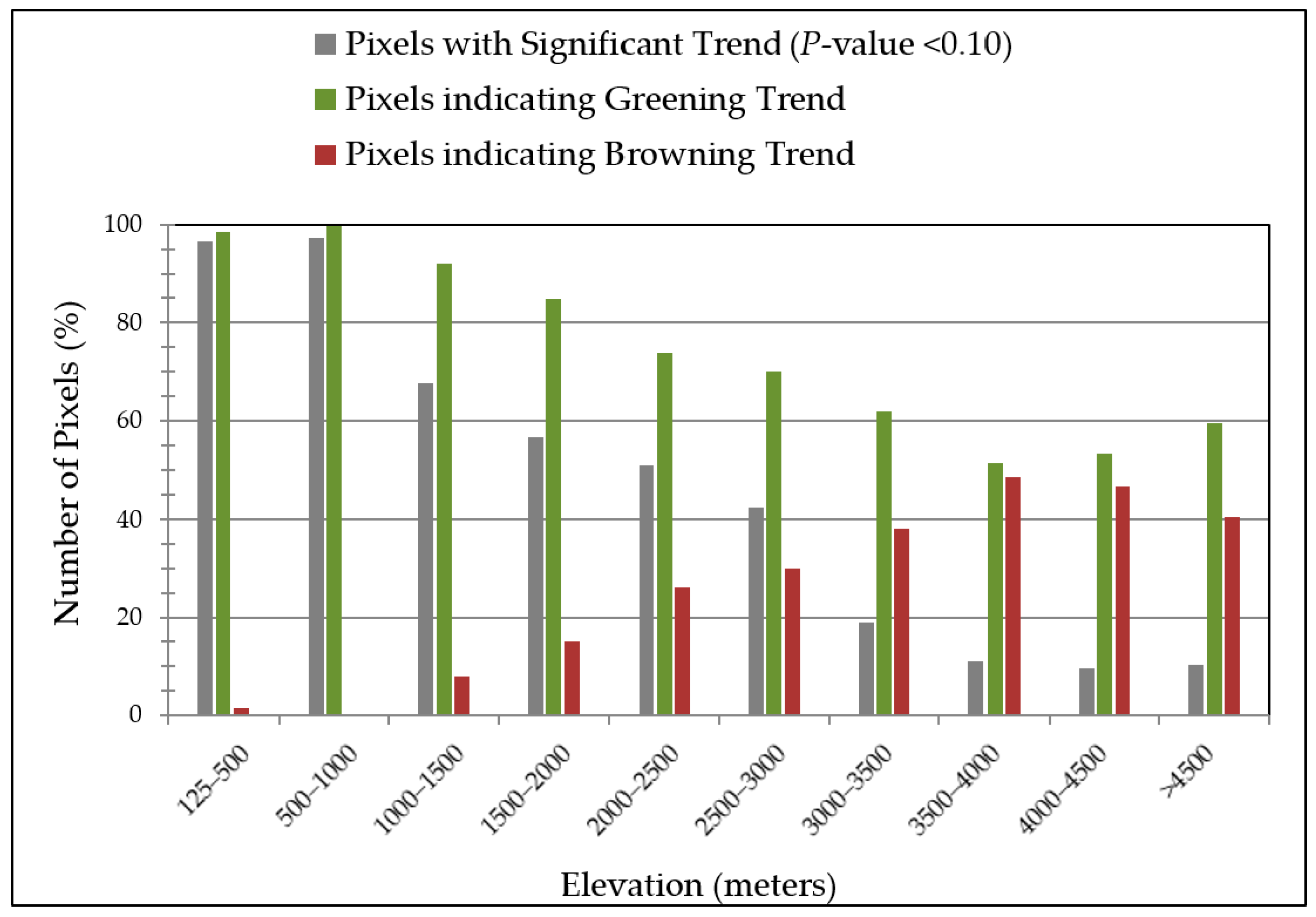
| PPM | Description | Ecological Meaning |
|---|---|---|
| Growing season length (GSL) | Number of days between start and end of growing season | Number of days when forage is available |
| Seasonal cumulative NDVI * (SCN) | Cumulative positive NDVI values of the season | Proxy for seasonal primary production of vegetation |
| Seasonal maximum NDVI * (SMN) | Maximum NDVI value of the season | Proxy for maximum forage biomass during the season |
| Ecological Zone | Description | Elevation (masl) | Elevation Range (masl) |
|---|---|---|---|
| Humid sub-tropical zone (HSZ) | Winter pastures. Grasses and forbs along with the green leaves from species such as Olea ferruginea, Grewia optiva, Acacia modesta and Prosopis sp. | 300–1000 | Range 1 (<500) |
| Range 2 (500–1000) | |||
| Moist temperate zone (TZ) | Grazing staging areas. Predominantly forest zones with forage areas for livestock grazing during the summer growing season | 1000–3000 | Range 3 (1000–1500) |
| Range 4 (1500–2000) | |||
| Range 5 (2000–2500) | |||
| Range 6 (2500–3000) | |||
| Sub-alpine zone (SAZ) | Dominated primarily by Kobersia sp. turf. Sibbaldia cuneata, Trifolium sp. and Poa pratensis are also dominant at various sites | 3000–4000 | Range 7 (3000–3500) |
| Range 8 (3500–4000) | |||
| Alpine zone (AZ) | Short summer grazing, dominated by Festuca, Poa, Lolium, Eragrostis, Danthonia, and Phleum, as well as many forbs, such as Primula, Aremons, Fritillaria, and Gentiana sp. | >4000 | Range 9 (4000–4500) |
| Range 10 (>4500) |
| Zone | Elevation (m) | GSL | SMN | SCN | ||||||||||||
|---|---|---|---|---|---|---|---|---|---|---|---|---|---|---|---|---|
| Mean | Tmp.Std. | Spt.Std. | Tmp.Cov. | Spt.Cov. | Mean | Tmp.Std. | Spt.Std. | Tmp.Cov. | Spt.Cov. | Mean | Tmp.Std. | Spt.Std. | Tmp.Cov. | Spt.Cov. | ||
| HSZ | 300–500 | 122 | 8.97 | 10.57 | 0.07 | 0.09 | 0.16 | 0.022 | 0.028 | 0.14 | 0.17 | 1.3 | 0.156 | 0.19 | 0.12 | 0.15 |
| 500–1000 | 120 | 9.3 | 9.99 | 0.08 | 0.08 | 0.17 | 0.023 | 0.035 | 0.14 | 0.21 | 1.31 | 0.149 | 0.22 | 0.11 | 0.17 | |
| MTZ | 100–1500 | 127 | 6.01 | 27.13 | 0.05 | 0.21 | 0.26 | 0.017 | 0.142 | 0.07 | 0.27 | 1.99 | 0.15 | 1.05 | 0.08 | 0.53 |
| 1500–2000 | 138 | 8.65 | 26.84 | 0.06 | 0.19 | 0.28 | 0.015 | 0.134 | 0.05 | 0.28 | 2.32 | 0.188 | 1.05 | 0.08 | 0.45 | |
| 2000–2500 | 149 | 8.8 | 26.3 | 0.06 | 0.18 | 0.3 | 0.018 | 0.114 | 0.06 | 0.29 | 2.52 | 0.21 | 1.01 | 0.08 | 0.4 | |
| 2500–3000 | 155 | 7.88 | 27.07 | 0.05 | 0.17 | 0.34 | 0.018 | 0.124 | 0.05 | 0.3 | 2.85 | 0.191 | 1.07 | 0.07 | 0.38 | |
| SAZ | 3000–3500 | 172 | 17.75 | 21.53 | 0.1 | 0.13 | 0.43 | 0.016 | 0.138 | 0.04 | 0.34 | 3.25 | 0.355 | 1.07 | 0.11 | 0.33 |
| 3500–4000 | 165 | 20.65 | 19.57 | 0.13 | 0.12 | 0.41 | 0.017 | 0.148 | 0.04 | 0.34 | 2.88 | 0.371 | 1.14 | 0.13 | 0.39 | |
| AZ | 4000–4500 | 146 | 19.98 | 21.98 | 0.14 | 0.15 | 0.29 | 0.013 | 0.154 | 0.05 | 0.34 | 1.83 | 0.256 | 1.1 | 0.14 | 0.6 |
| >4500 | 130 | 17.49 | 22.7 | 0.13 | 0.17 | 0.15 | 0.008 | 0.1 | 0.05 | 0.33 | 0.83 | 0.13 | 0.67 | 0.16 | 0.8 | |
| Ecological Zone | Elevation (m) | Temperature (r) | Rainfall (r) |
|---|---|---|---|
| Humid sub-tropical zone (HSZ) | 300–500 | −0.22 | 0.74 |
| 500–1000 | −0.29 | 0.75 | |
| Moist temperate zone (TZ) | 1000–1500 | −0.21 | 0.53 |
| 1500–2000 | −0.20 | 0.51 | |
| 2000–2500 | −0.19 | 0.40 | |
| 2500–3000 | −0.16 | 0.32 | |
| Sub-alpine zone (SAZ) | 3000–3500 | −0.05 | 0.27 |
| 3500–4000 | −0.02 | 0.00 | |
| Alpine zone (AZ) | 4000–4500 | −0.02 | 0.16 |
| >4500 | −0.02 | 0.13 |
© 2016 by the authors; licensee MDPI, Basel, Switzerland. This article is an open access article distributed under the terms and conditions of the Creative Commons Attribution (CC-BY) license (http://creativecommons.org/licenses/by/4.0/).
Share and Cite
Qamer, F.M.; Xi, C.; Abbas, S.; Murthy, M.S.R.; Ning, W.; Anming, B. An Assessment of Productivity Patterns of Grass-Dominated Rangelands in the Hindu Kush Karakoram Region, Pakistan. Sustainability 2016, 8, 961. https://doi.org/10.3390/su8090961
Qamer FM, Xi C, Abbas S, Murthy MSR, Ning W, Anming B. An Assessment of Productivity Patterns of Grass-Dominated Rangelands in the Hindu Kush Karakoram Region, Pakistan. Sustainability. 2016; 8(9):961. https://doi.org/10.3390/su8090961
Chicago/Turabian StyleQamer, Faisal Mueen, Chen Xi, Sawaid Abbas, Manchiraju S. R. Murthy, Wu Ning, and Bao Anming. 2016. "An Assessment of Productivity Patterns of Grass-Dominated Rangelands in the Hindu Kush Karakoram Region, Pakistan" Sustainability 8, no. 9: 961. https://doi.org/10.3390/su8090961
APA StyleQamer, F. M., Xi, C., Abbas, S., Murthy, M. S. R., Ning, W., & Anming, B. (2016). An Assessment of Productivity Patterns of Grass-Dominated Rangelands in the Hindu Kush Karakoram Region, Pakistan. Sustainability, 8(9), 961. https://doi.org/10.3390/su8090961







